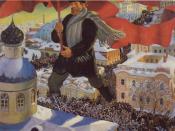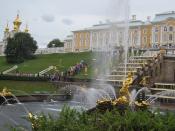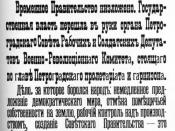Social revolts and an economic decline caused the Russian Revolution of 1917, which in turn caused Russia to experience major political and social changes. The common people of Russia, prior to the revolution, were extremely poor (Harvey 4). The government was said to be unfair by the majority of people and everyone seemed to have different ideas on how to make the country and its government work for everyone (Cash 51). The people brought this revolution upon themselves when they rebelled against the czarist reign and a new form of government became necessary (Harvey 4-5).
The government, nobles, and peasants made up Russia's social classes. "Most of the people in Russia from the middle ages until 1917 were peasant farmers, bound to the soil" (Resnick 51). These peasants were known as serfs. Serfs are bound to serve a master, farm the master's land, and give their master a certain part of everything that they grow.
The land owners that owned serfs were often revolted against. These revolts were minor, and usually not related. They were, however, very violent. "Noblemen were hanged, burned, beaten, whipped, and torn limb from limb" (Resnick 53). Up until the time of the revolution, Russia had been a czarist government. In Russia, only the czar and few others held the power and wealth, enabling them to own all the land and businesses (Harvey 5). The czar and his family lived in a palace located in St. Petersburg (Resnick 53).
Russia's economic decline was caused mainly by the oppression of people other than the czars and wealthy people. This left many of the less fortunate people hungry and forced to earn a meager living. "In 1917 Russia was still primarily an agricultural and rural society" (Kort 7). Many places throughout Russia had a very limited supply...


